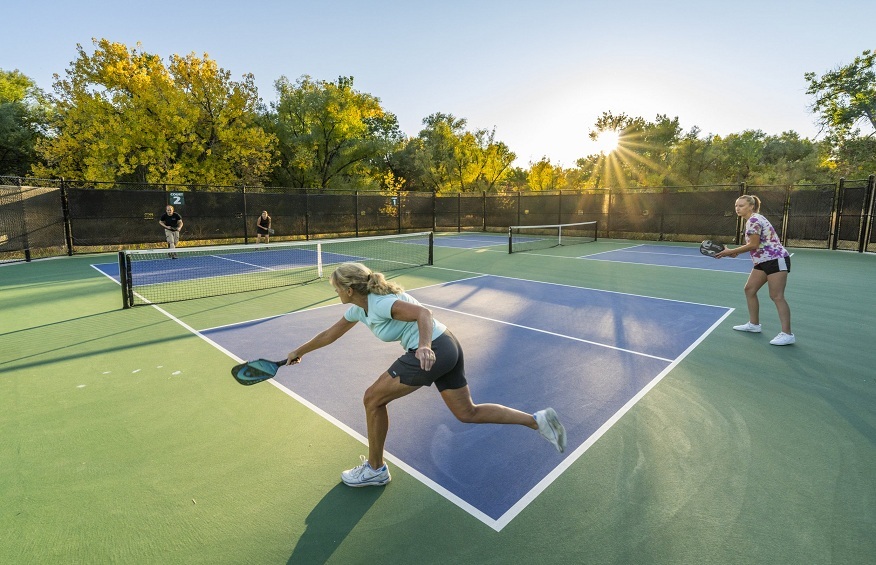Pickleball, a sport that combines elements of tennis, badminton, and table tennis, is celebrated for its accessibility and versatility. One of the core rules that differentiates pickleball from its racquet-sport cousins is the “double bounce” rule. This rule is a fundamental aspect of the game, shaping the dynamics of rallies and encouraging strategic play. In this comprehensive guide, we will explore the American pickleball double bounce rule, providing an in-depth understanding of its significance, impact on gameplay, and how it enhances the sport.
The Basics of the Double Bounce Rule
The American pickleball double bounce rule states that both teams must allow the ball to bounce once on each side of the net before volleys (hitting the ball in the air) are allowed. This rule is a cornerstone of pickleball and sets it apart from sports like tennis, where volleys are common from the very start of a point.
How the Rule Works
Serve: The serving team initiates the point. The server must stand behind the baseline and serve the ball diagonally to the opponent’s service court.
First Bounce: After the serve, the receiving team allows the ball to bounce once on their side before they can return it. The serving team must also allow the return to bounce before making a volley.
Volleying: Once both teams have allowed the ball to bounce, volleys are permitted. A volley is when a player hits the ball in the air before it bounces on their side. Players can continue to volley the ball as long as it is struck without letting it bounce.
The double bounce rule remains in effect until the ball clears the non-volley zone, also known as the “kitchen.”
The Significance of the Rule
The American pickleball double bounce rule serves several crucial purposes that contribute to the sport’s unique characteristics and appeal:
1. Inclusivity
The double bounce rule levels the playing field, making pickleball accessible to players of varying skill levels. Since volleys are not allowed until after the first two bounces, it allows beginners and less agile players to participate competitively. This inclusivity is a key reason why pickleball is often dubbed “the sport for all ages.”
Read More: 3 Top-Quality Body Lotions to Avail
2. Strategy
The rule adds a strategic dimension to the game. It forces players to think ahead and plan their shots carefully. Strategic placement and patience are rewarded, and players often aim to create opportunities by maneuvering their opponents into unfavorable positions.
3. Longer Rallies
By necessitating a double bounce before volleys, the rule leads to longer rallies. These extended exchanges make pickleball exciting and engaging for both players and spectators. The unpredictability of the longer rallies adds an element of suspense to each point.
4. Reduced Dominance of Power
In sports where volleys are allowed immediately, power and speed can dominate. In pickleball, due to the double bounce rule, players have the chance to react, position themselves, and use finesse shots effectively. The rule encourages a more balanced approach to the game.
The Double Bounce Rule in Action
Understanding how the double bounce rule influences pickleball rallies is key to appreciating its significance. Let’s examine the typical sequence of events during a point:
Serve: The serving team initiates the point with an underhand serve. The receiving team allows the serve to bounce on their side.
Return: The receiving team returns the serve with the goal of placing it strategically. The serving team, in turn, allows the return to bounce.
Volleying Begins: Once both teams have allowed the ball to bounce on their side, volleys become legal. Players can now attempt volleys and more aggressive shots.
Rally: The point continues with volleys, groundstrokes, and volleys until one team wins the rally by forcing an error, hitting a winner, or benefiting from a fault by the opponents.
Non-Volley Zone: It’s important to note that volleys are not allowed within the non-volley zone. Players must move out of the kitchen to volley, which adds a tactical element to the game.
Exception to the Rule
One exception to the double bounce rule is the “3rd shot drop.” Many players use this strategy to regain control of the kitchen. After the serve and return have occurred, players may attempt a soft, precise drop shot that gently lands in the kitchen on the opponent’s side. This strategic move can help shift the balance of play and provide the serving team with an advantageous position near the net.
Conclusion
The American pickleball double bounce rule is at the heart of the sport’s charm. It promotes inclusivity, encourages strategic thinking, leads to longer rallies, and balances the playing field. By requiring players to let the ball bounce once on each side before volleys are permitted, pickleball fosters an environment where skill, finesse, and cunning placement are just as important as power.
As players step onto the pickleball court, they embrace the essence of the sport—the art of constructing points, anticipating their opponents’ moves, and making the most of the double bounce rule. It is this dynamic interaction between players and the court that makes pickleball a captivating and rewarding sport for all who participate.

